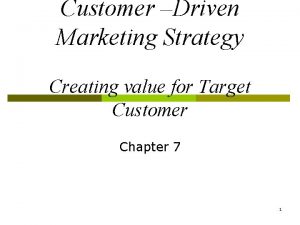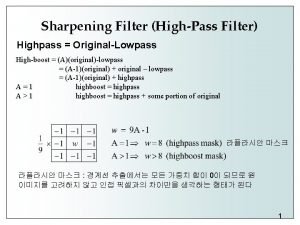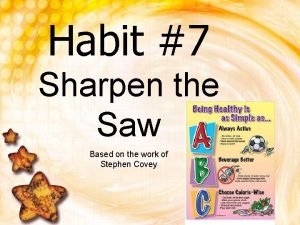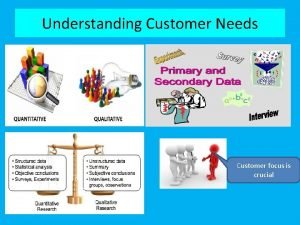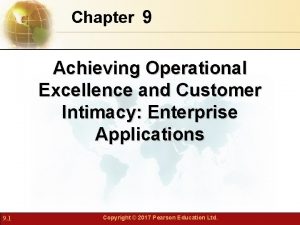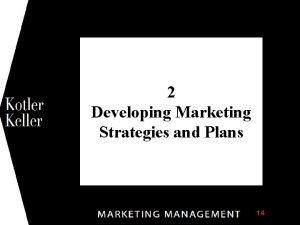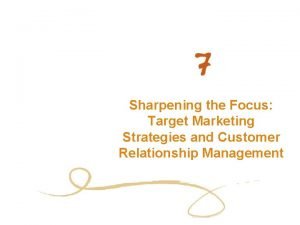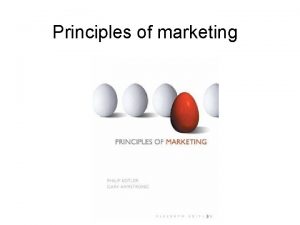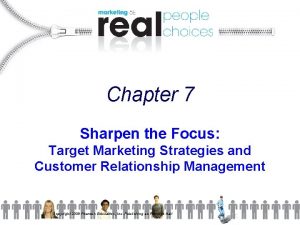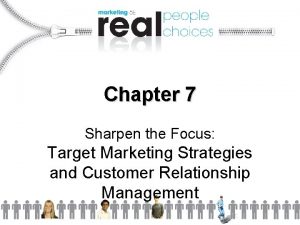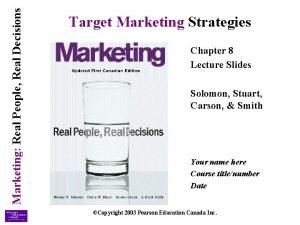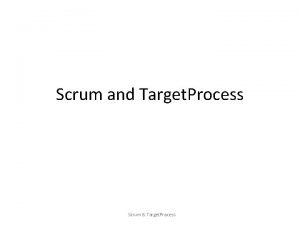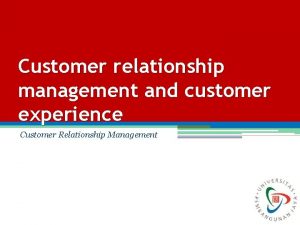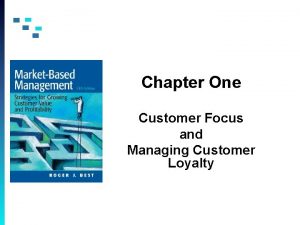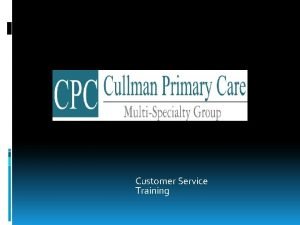Sharpening the Focus Target Marketing Strategies and Customer






























- Slides: 30

Sharpening the Focus: Target Marketing Strategies and Customer Relationship Management

Chapter Objectives • Understand the need for market segmentation in today’s business environment • Know the different dimensions that marketers use to segment consumer and business-to-business markets • Show marketers evaluate and select potential market segments • Explain how marketers develop a targeting strategy • Understand how a firm develops and implements a positioning strategy • Explain how marketers increase long-term success and profits by practicing customer relationship management 2

Real People, Real Choices • Reebok (Que Gaskins) • How to capture the pulse of youth culture in the long run? Ø Option 1: mimic Nike’s moves with Michael Jordan Ø Option 2: build on Reebok’s success with Iverson, while separating the brand from other performance sneaker brands like Nike Ø Option 3: maintain the Iverson emphasis and increase efforts to build credibility as a shoe for soccer and track 3

Target Marketing Strategy: Selecting and Entering a Market • Market fragmentation: The creation of many consumer groups due to the diversity of their needs and wants. • Target marketing strategy: dividing the total market into different segments based on customer characteristics, selecting one or more segments, and developing products to meet those segments’ needs. 4

Steps in the Target Marketing Process • Segmentation • Targeting • Positioning 5

Step 1: Segmentation • The process of dividing a larger market into smaller pieces based on one or more meaningful shared characteristics • Segmentation variables: dimensions that divide the total market into fairly homogeneous groups, each with different needs and preferences 6

Segmenting Consumer Markets • Segmentation variables can slice up the market Ø Demographic, psychological, and behavioral differences 7

Segmenting by Demographics Age: Generational Marketing • • • Children Teens/tweens Generation Y: born between 1977 and 1994 Generation X: born between 1965 and 1976 Baby boomers: born between 1946 and 1964 Older consumers 8

Segmenting by Demographics Gender • Many products appeal to one sex or the other • Metrosexual: a man who is heterosexual, sensitive, educated, and an urban dweller in touch with his feminine side 9

Segmenting by Demographics (cont’d) • • Family Structure Income Social Class Race and Ethnicity Ø African Americans Ø Asian Americans Ø Hispanic Americans 10

Segmenting by Geography • Geodemography: combines geography with demographics • Geocoding: Customizes Web advertising so people who log on in different places see ad banners for local businesses 11

Segmenting by Psychographics • Psychographics: The use of psychological, sociological and anthropoligical factors to construct market segments. • AIOs: Psychographics segments consumers in terms of shared activities, interests, and opinions. 12

Segmenting by Behavior • Segments consumers based on how they act toward, feel about, or use a product • 80/20 rule: 20 percent of purchasers account for 80 percent of a product’s sales • Heavy, medium, and light users and nonusers of a product • Usage occasions 13

Segmenting Business-to-Business Markets • By organizational demographics • By production technology used • By whether customer is a user/nonuser of product • By North American Industry Classification System (NAICS) 14

Step 2: Targeting • Marketers evaluate the attractiveness of each potential segment and decide in which they will invest resources to try to turn them into customers • Target market: customer group(s) selected 15

Evaluation of Market Segments • A viable target segment should: Ø Have members with similar product needs/wants Ø Be measurable in size and purchasing power Ø Be large enough to be profitable Ø Be reachable by marketing communications Ø Have needs the marketer can adequately serve 16

Developing Segment Profiles • Need to develop a profile or description of the “typical” customer in a segment. • Segment profile might include demographics, location, lifestyle, and product-usage frequency. 17

Choosing a Targeting Strategy • Undifferentiated targeting: appealing to a broad spectrum of people • Differentiated targeting: developing one or more products for each of several customer groups • Concentrated targeting: offering one or more products to a single segment 18

Choosing a Targeting Strategy (cont’d) • Custom marketing: tailoring specific products to individual customers • Mass customization: modifying a basic good or service to meet the needs of an individual 19

Step 3: Positioning • Developing a marketing strategy aimed at influencing how a particular market segment perceives a good/service in comparison to the competition 20

Steps in Developing a Positioning Strategy • Analyze competitors’ positions. • Offer a good/service with competitive advantage. • Match elements of the marketing mix to the selected segment. • Evaluate target market’s responses and modify strategies if needed. 21

Positioning (cont’d) • Repositioing: redoing a product’s position to respond to marketplace changes. • Retro brand: a once-popular brand that has been revived to experience a popularity comeback, often by riding a wave of nostalgia. 22

The Brand Personality • A distinctive image that captures the brand’s character and benefits • Perceptual map: a picture of where products/brands are “located” in consumers’ minds 23

Customer Relationship Management (CRM) • Sees marketing as a process of building long-term relationships with customers to keep them satisfied and coming back. • CRM facilitates one-to-one marketing. 24

Four Steps in One-to-One Marketing • Identify customers; know them in as much detail as possible. • Differentiate customers by their needs and value to the company. • Interact with customers; find ways to improve the interaction. • Customize some aspect of the products you offer each customer. 25

CRM: A New Perspective on an Old Problem • CRM systems use computers, software, databases, and the Internet to capture information at each touch point between customers and companies, to allow better customer care. • CRM proposes that customers are relationship partners, with each partner learning from the other every time they interact. 26

Characteristics of CRM • • Share of customer (vs. share of market) Lifetime value of the customer Customer equity Focus on high-value customers 27

Real People, Real Choices • Reebok (Que Gaskins) • Que chose option 2: build on Reebok’s success with Iverson, while separating the brand from other performance sneaker brands like Nike Ø Reebok created a new category called Rbk that fuses sports with youth lifestyle and entertainment 28

Marketing in Action Case: You Make the Call • What is the decision facing Oracle? • What factors are important in understanding this decision situation? • What are the alternatives? • What decision(s) do you recommend? • What are some ways to implement your recommendation? 29

Keeping It Real: Fast Forward to Next Class Decision Time at Black & Decker • Meet Eleni Rossides, a senior manager in the Black & Decker Consumer Group. • Scum. Buster users had recommended product improvements. • The decision: What changes, if any, to make in the Scum. Buster. 30
 Target marketing strategies
Target marketing strategies Target marketing strategies
Target marketing strategies Image sharpening in digital image processing
Image sharpening in digital image processing Integrated cost leadership/differentiation strategy
Integrated cost leadership/differentiation strategy Differentiation business level strategy
Differentiation business level strategy Is garbage rotting a chemical change
Is garbage rotting a chemical change Sharpening spatial filter
Sharpening spatial filter Combining spatial enhancement methods
Combining spatial enhancement methods Filter sharpen
Filter sharpen Image sharpening
Image sharpening Sharpen the saw soul
Sharpen the saw soul Wit sharpening potion
Wit sharpening potion Primary target market and secondary target market
Primary target market and secondary target market Language
Language Actor focus vs object focus
Actor focus vs object focus Basic focus strategies for services
Basic focus strategies for services Market orientation
Market orientation Customer focus examples
Customer focus examples Focus on the customer
Focus on the customer Price target strategies
Price target strategies Customer relationship management and customer intimacy
Customer relationship management and customer intimacy Customer relationship management and customer intimacy
Customer relationship management and customer intimacy Intimacy
Intimacy Customer service in retail management
Customer service in retail management Customer management techniques
Customer management techniques Despite the data glut that marketing managers
Despite the data glut that marketing managers Pengertian customer relationship
Pengertian customer relationship Beyond customer satisfaction
Beyond customer satisfaction Chapter 2 developing marketing strategies and plans summary
Chapter 2 developing marketing strategies and plans summary Developing marketing strategies and plans
Developing marketing strategies and plans Ilumination
Ilumination

